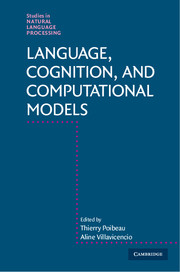Book contents
- Frontmatter
- Contents
- Figures
- Tables
- Contributors
- Part I About This Book
- Part II Models of Neural and Cognitive Processing
- Part III Data Driven Models
- Part IV Social and Language Evolution
- 9 Social Evolution of Public Languages: Between Rousseau's Eden and Hobbes’ Leviathan
- 10 Genetic Biases in Language: Computer Models and Experimental Approaches
- 11 Transparency versus Processing Efficiency: A Case Study on German Declension
- Index
- References
11 - Transparency versus Processing Efficiency: A Case Study on German Declension
from Part IV - Social and Language Evolution
Published online by Cambridge University Press: 30 November 2017
- Frontmatter
- Contents
- Figures
- Tables
- Contributors
- Part I About This Book
- Part II Models of Neural and Cognitive Processing
- Part III Data Driven Models
- Part IV Social and Language Evolution
- 9 Social Evolution of Public Languages: Between Rousseau's Eden and Hobbes’ Leviathan
- 10 Genetic Biases in Language: Computer Models and Experimental Approaches
- 11 Transparency versus Processing Efficiency: A Case Study on German Declension
- Index
- References
Summary
Abstract
Ambiguity is one of the most fascinating mysteries of human language that divides the linguistic research field in roughly two camps: the mainstream view, which considers ambiguity to be undesirable for communication; and the cognitive-functional view, which argues that ambiguity allows for more efficient communication. This chapter subscribes to the cognitive-functional view and presents a case study on the German declension system, which is notorious for its ambiguity through the use of syncretic case forms. Through amethodology based on computational reconstruction, the paper suggests that the current declension system outperforms its historical predecessors in terms of efficient communication, while featuring a labor-saving distribution of morphological marking across articles, adjectives, and nouns.
Introduction
Intuitively speaking, successful communication requires languages to exhibit a transparent mapping between meaning and form. Cross-linguistic research, however, shows that such transparency is the exception rather than the rule (Leufkens, 2015). Indeed, computational linguists will sometimes jokingly admit that they only have three problems to solve: ambiguity, ambiguity, and ambiguity.
Ambiguity is a major puzzle that divides the study of natural language in roughly two views (Winkler, 2015). One view, most outspokenly assumed by Chomskyan linguistics, considers ambiguity to be harmful for communication – an assumption that is sometimes used for arguing that language is in fact “poorly designed” for communication (Chomsky, 2008, p. 136). The opposing view, defended in cognitive-functional approaches to language, argues that ambiguity makes inferential communication systems more efficient (Piantadosi et al., 2012).
This study subscribes to the cognitive-functional approach and argues that ambiguity may lead to greater efficiency in language processing. As a case study, the chapter focuses on why case syncretism has emerged in the German declension system. Syncretism occurs when the same form can be mapped onto different grammatical functions. One example is the English suffix -s, which can be used as a number marker in nouns (e.g. cats) or as a conjugation marker in verbs discovers. Often enough, these functions may be contradictory: as a nominal marker, -s expresses plurality, but when used as a verbal suffix, it expresses agreement with a singular subject. The German declension system in particular is notorious for this kind of syncretism, which has puzzled many linguists for decades (see a.o. Bierwisch, 1967; Blevins, 1995;Wiese, 1996;Wunderlich, 1997; Müller, 2001; Daniels, 2001; Müller, 2002; Crysmann, 2005; Dalrymple et al., 2009).
Information
- Type
- Chapter
- Information
- Language, Cognition, and Computational Models , pp. 289 - 318Publisher: Cambridge University PressPrint publication year: 2018
